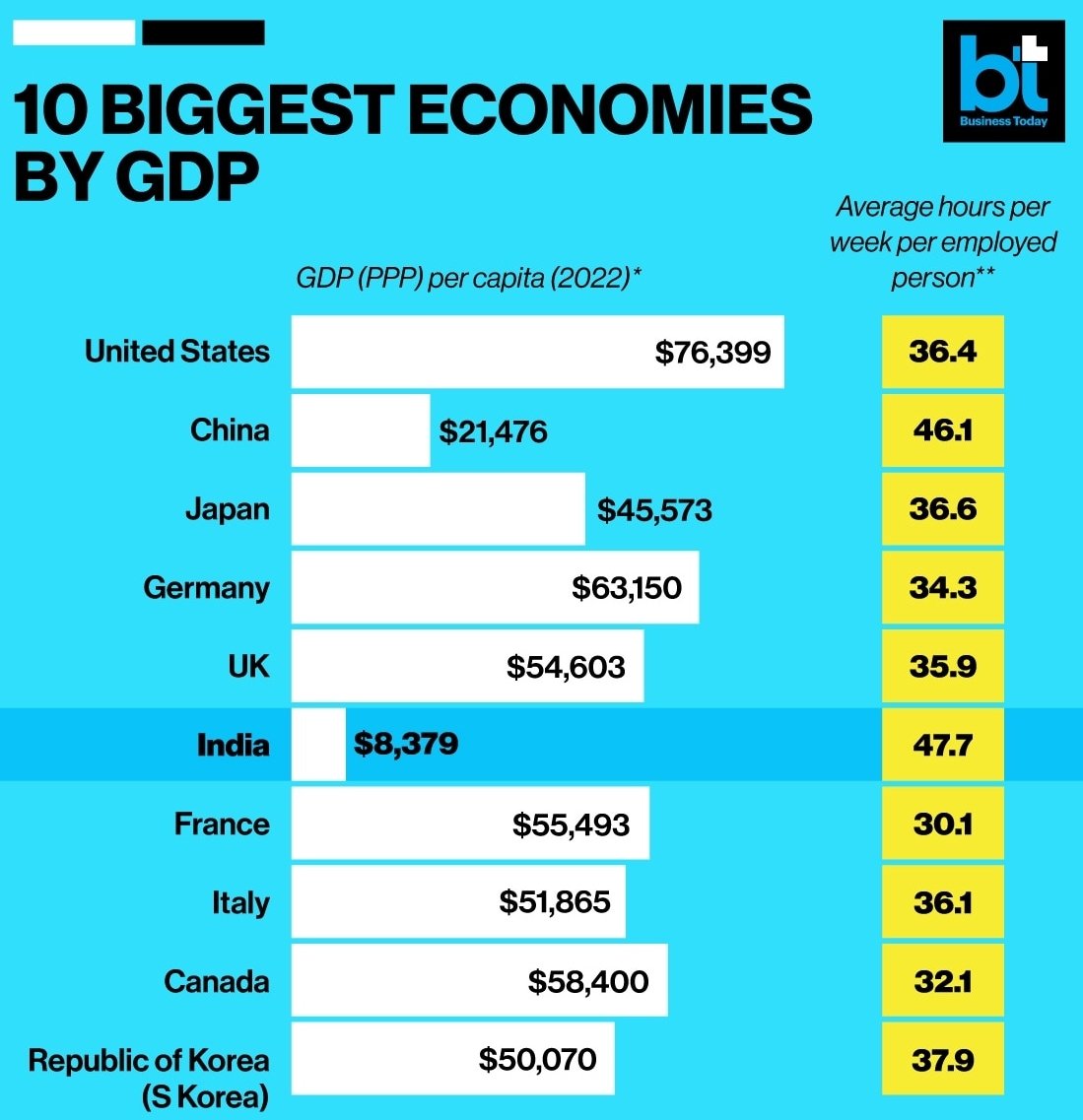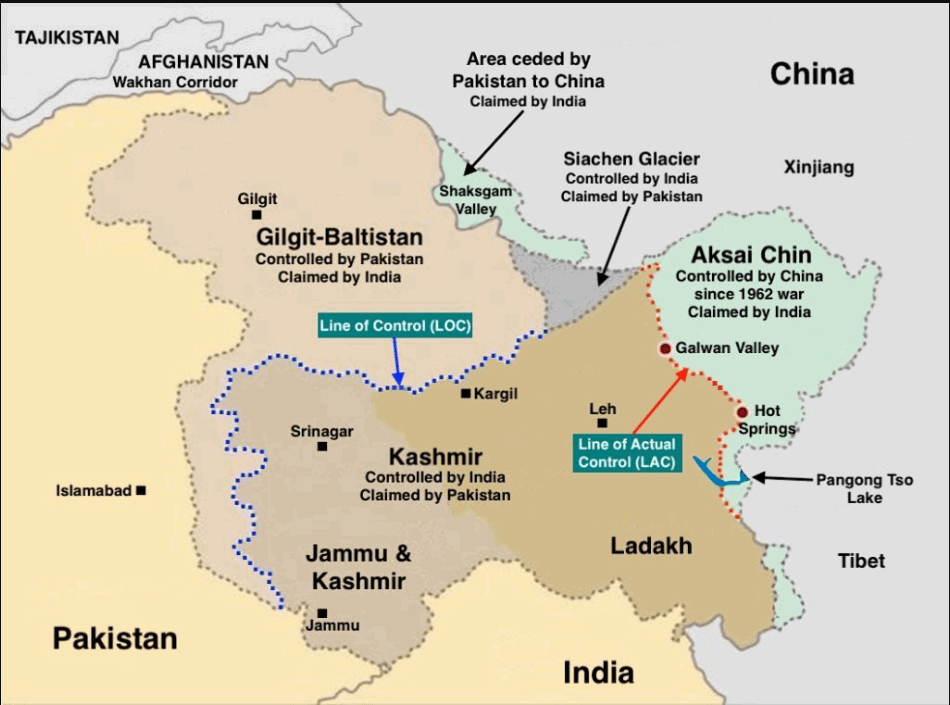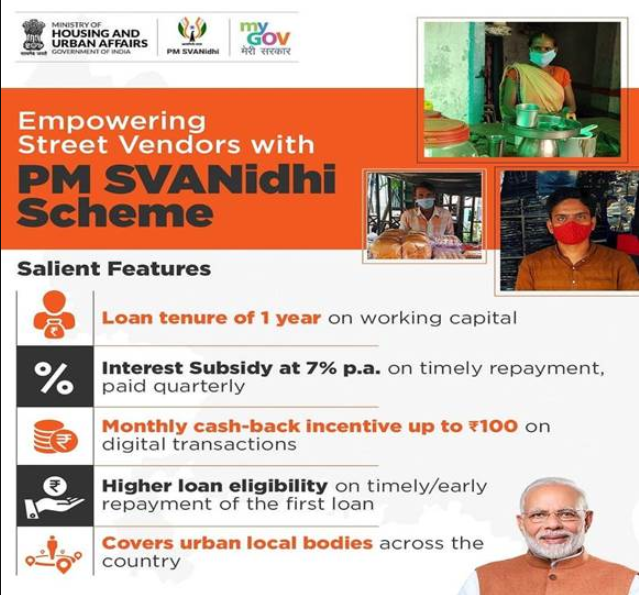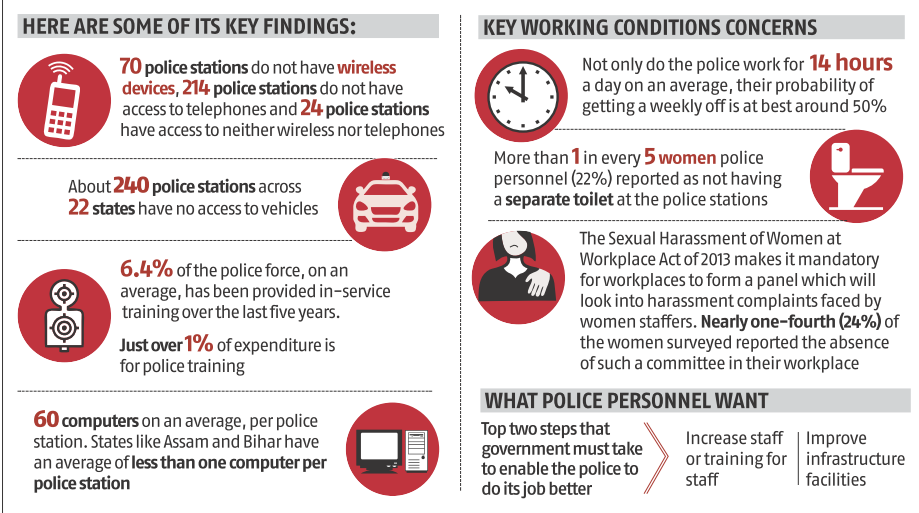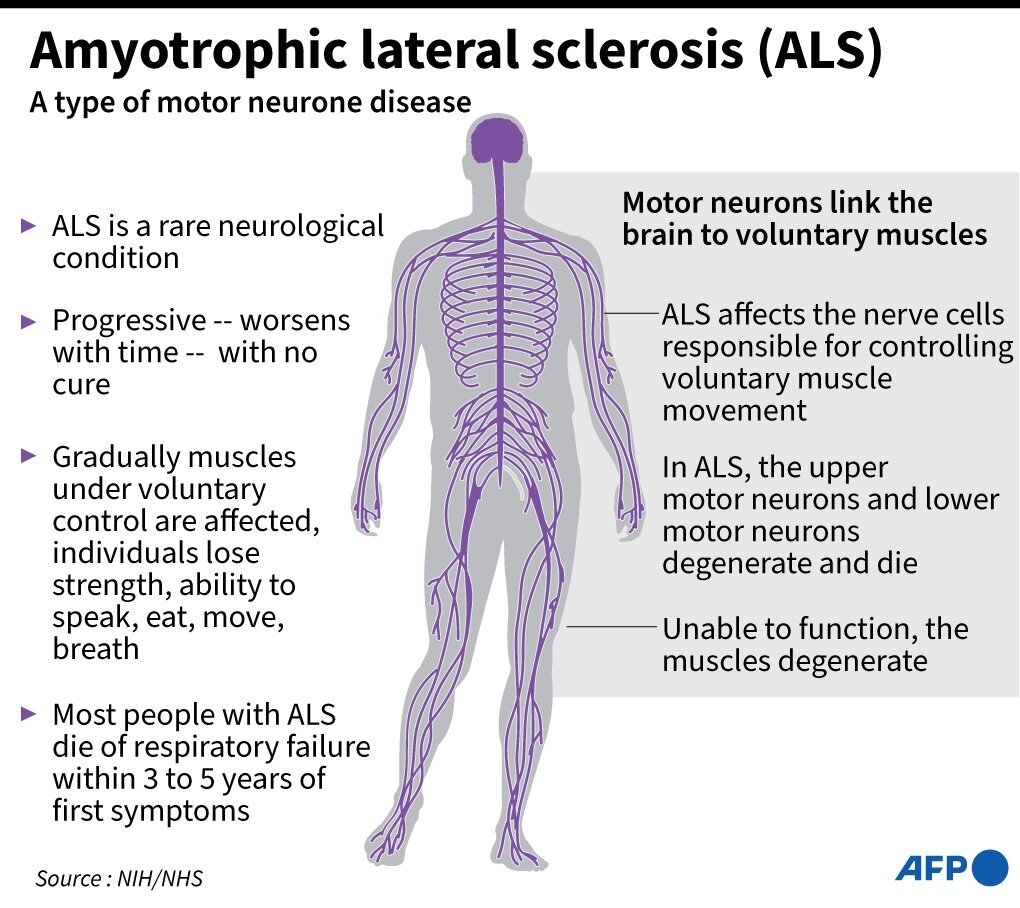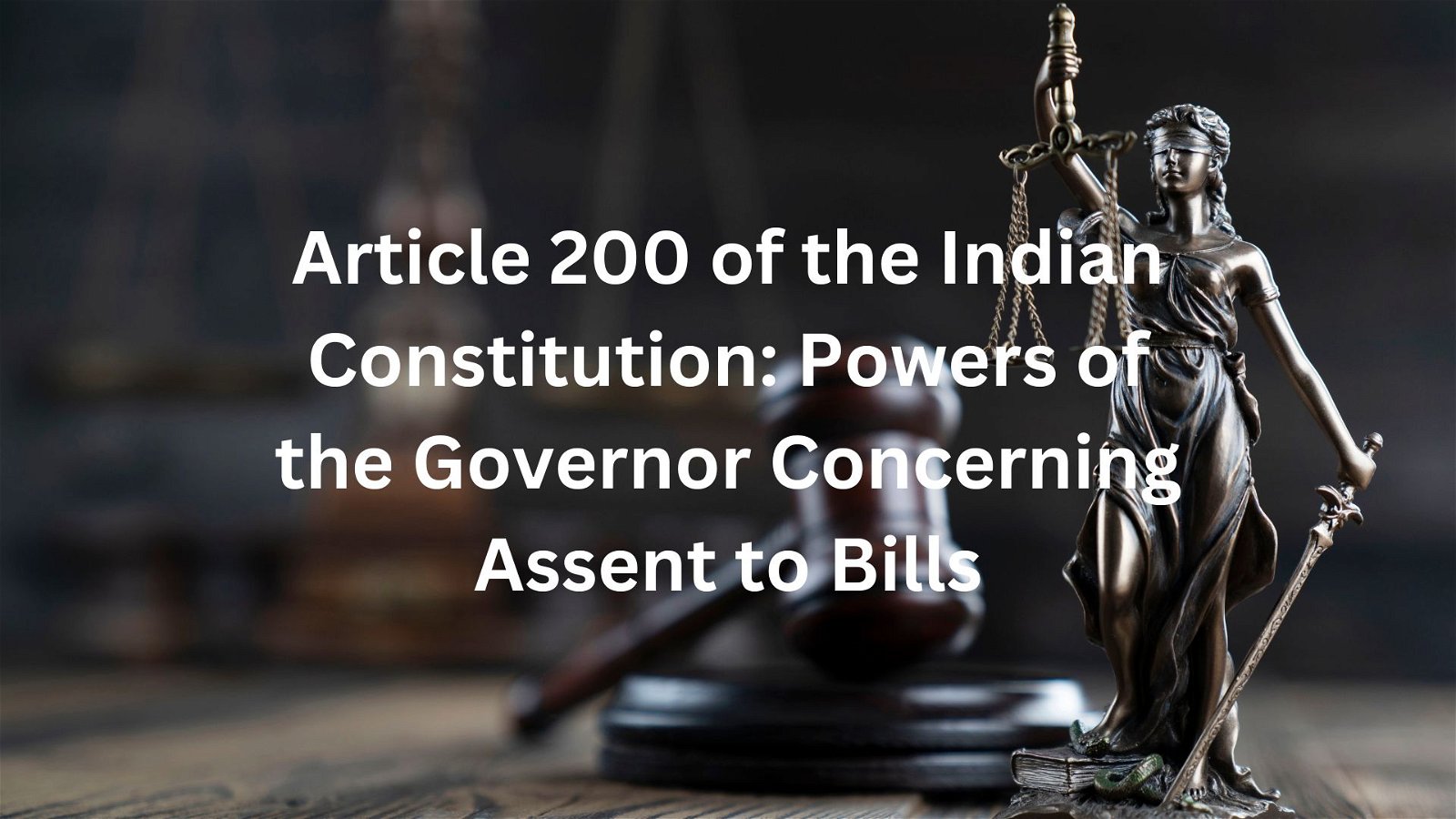
Current Affairs February 28, 2024: Assam Muslim Marriage & Divorce Registration Act of 1935, Women in Defence Forces, Court Vacations, Genome India Project, Gaganyaan Mission, High Tariffs in India, Agalega Island
Subscribers of "Current Affairs" course can Download Daily Current Affairs in PDF/DOC
Subscribe to Never Miss an Important Update! Assured Discounts on New Products!
Must Join PMF IAS Telegram Channel & PMF IAS History Telegram Channel
{GS2 – Governance – Laws} Assam Muslim Marriage & Divorce Registration Act of 1935
- Context (TH I IE): The Assam government has decided to repeal the Assam Muslim Marriages and Divorces Registration Act of 1935.
- Enacted in 1935, the Act lays down the process for registration of Muslim marriages and divorces.
- The Act was in line with the Muslim personal law.
Features of the Act
- It Authorises the state to grant licences to “any person, being a Muslim” to register marriages and divorces, with Muslim registrars (Kazi) deemed to be public servants.
- A 2010 amendment replaced the word ‘voluntary’ in the original Act with ‘compulsory’, making registration of Muslim marriages and divorces compulsory in the state of Assam.
Assam Government’s Rationale for Repealing
- As a measure to combat child marriages, citing provisions in the Act that permit marriage registration even if the individuals involved are below the legal marriageable age.
- Many kazis misuse the power, and often enable the marrying of minors and divorce without grounds.
- Registration machinery in the Act is “informal” therefore “leaving a lot of scope for non-compliance of extant norms”.
- A step towards implementing UCC in the state.
Registration of Marriages after repealing the Act
- After the Act’s repeal, Muslims will have to register marriages under the Special Marriage Act.
- District commissioners and district registrars will be authorised to take custody of registration records currently in the custody of 94 Muslim marriage registrars (Kazis).
- A one-time compensation of ₹2 lakh will be provided to each Muslim marriage registrar for their rehabilitation after the Act is repealed.
{GS2 – Polity – IC – Judiciary} Court Vacations
- Context (IE): CJI recently spoke about the criticism often made towards the number of vacation days awarded to Indian judges.
- Then Law Minister Kiren Rijiju also criticized the judiciary for taking long vacations even as pending cases hit record levels every year.
Duration of Court Vacations
- The 1958 statute: Vacation means such periods during a year fixed by SC rules with the prior approval of the President.
- The current rule followed by SC for vacation is SC Rules, 2013 and CJI issues notifications for the vacation every year.
Supreme Court
- The SC has 193 working days a year for its judicial functioning.
- The SC breaks for its annual summer vacation which is typically for seven weeks.
- A week-long break each for Dussehra and Diwali and two weeks at the end of December.
High Court
- High Courts function for approximately 210 days.
- High Courts have the power to structure their calendars according to the service rules.
Trial Courts
- Trial Courts function for approximately 245 days.
- The subordinate criminal courts do not have any vacation, but the subordinate civil courts have vacations.
What Happens to Important Cases During Court Vacations?
- Generally, a few judges are available to hear urgent cases even when the court is in recess.
- “Vacation Benches” comprising two or three judges hear important cases that cannot wait.
Vacation Bench
- A Vacation Bench of the SC is a special bench constituted by the CJI.
- Litigants can still approach the SC and, if the court decides that the plea is an “urgent matter”, the Vacation Bench hears the case on its merits.
- It is not uncommon for courts to hear important cases during vacations.
- In 2015, SC heard the challenge to the constitutional amendment setting up the National Judicial Appointments Commission (NJAC) during the summer vacation.
- In 2017, a Constitution Bench held a six-day hearing in the case challenging the practice of triple talaq during summer vacation.
Legal Provisions
- Under Rule 6 of The SC rules, 2013, the CJI has nominated the Division Benches for hearing of urgent miscellaneous matters and regular hearing matters during the summer vacation for the period.
- CJI may appoint one or more Judges to hear during summer vacation or winter holidays all matters of an urgent nature which under these rules may be heard by a Judge sitting singly.
- And, whenever necessary, CJI may likewise appoint a Division Court for the hearing of urgent cases during the vacation which require to be heard by a Bench of Judges.
Need for Vacation
- Except on rare occasions like family tragedies or health issues, judges do not take leave of absence like other working professionals when the court is in session.
- Judges are overburdened on a daily basis and work extremely long hours. In the absence of sufficient breaks, judges will suffer a burnout.
- Many judges use the long breaks to write judgments that are pending and also catch up on research, which is essential for judges to maintain the quality of justice.
- They also have to perform administrative tasks like supervision of lower judiciary and appointment of judges.
- Role in reduction of pendency of cases – Reducing vacations will not see a dramatic decrease in pendency of cases, as pendency relates largely to legacy cases that need to be tackled systemically.
Issues with Court Vacations
-
Not Convenient for Justice Seekers: The long vacation which the courts obtain is not very convenient for justice-seekers.
- For an ordinary litigant, the vacation means further unavoidable delays in listing cases.
-
Not good Optics in Light of Pendency: Extended frequent vacations are not good optics, especially in the light of mounting pendency of cases and the slow pace of judicial proceedings.
- There is a backlog of over 3.1 crore cases in Indian courts.
- Incongruous with European Practices: The summer break perhaps began because European judges of the Federal Court of India found Indian summers too hot and took the winter break for Christmas.
- There are no governmental organizations in the country except courts and schools that have vacation.
Recommendations
Justice Malimath Committee
- In 2000, the period of vacation should be reduced by 21 days.
- It suggested that the SC work for 206 days, and HCs for 231 days every year.
Law Commission Report, 2009
- The vacations in the higher judiciary must be curtailed by at least 10 to 15 days and the court working hours should be extended by at least half an hour.
The Parliamentary Standing Committee on Personnel, Public Grievances, Law and Justice
- In its 133rd report mentioned that vacations in the judiciary are a ‘colonial legacy’ and entire court going on vacation causes deep inconvenience to the litigants.
SC on Vacations
- In 2014, when the pendency of cases hit the 2 crore mark, then CJI R M Lodha had suggested keeping the SC, HCs, and trial courts open round the year.
- Former CJI T S Thakur also suggested holding court during vacations if parties and lawyers mutually agreed.
- In 2014, when the SC notified its new Rules, it said that the period of summer vacation shall not exceed seven weeks from the earlier 10-week period.
{GS2 – Vulnerable Sections – Women} Women in Defence Forces
- Context (IE): SC directed the Ministry of Defence to pay Rs 60 lakh in compensation to a former permanent commissioned officer in the Military Nursing Service (MNS) ruling she was “wrongly” released from service in 1988 on grounds of her marriage.
|
History of Women in Indian Armed Forces
Pre Independence
- The role of women in the Indian Armed Forces began to take shape with the formation of the “Indian Military Nursing Service” in 1888.
- Role of women further expanded with the formation of the Women’s Auxiliary Corps, founded by the British run-Indian Army to recruit female volunteers for the Second World War in 1942.
- It allowed women to serve in primarily non-combatant roles like communications, accounting and administration.
- However, the women in the British Indian Army did not have the privilege of fighting in a combat role, unlike their European and American counterparts.
- Azad Hind Fauj, founded by Subhash Chandra Bose, had a women’s regiment, i.e. Rani of Jhansi Regiment, which saw active combat when it fought along Imperial Japanese Army in Burma.
Post Independence
- The Army Act, 1950 made women ineligible for regular commissions with certain exceptions specified by the central government.
- In 1958, the Army Medical Corps became the first Indian Army unit to award regular commissions to women.
- The induction of women officers into the Indian Army through the Women Special Entry Scheme (WSES) started in 1992, after the approval of the Cabinet Committee on Parliamentary Affairs.
- They were commissioned for five-year period in certain streams, like the Army Education Corps and the Corps of Engineers. The infantry and armoured corps were not open to them.
- It had shorter pre-commission training periods than those stipulated for men commissioned under the SSC scheme. Men were commissioned for 10-year periods, which could be extended up to 14 years.
- In 2006, the WSES scheme was replaced by the SSC (Short Service Commission) scheme for women. Existing WSES officers were given the option to move to the new scheme.
- In 2019, the government granted permanent commission to women officers in eight streams of the Army, in addition to the JAG and AEC, which it was granted earlier in 2008.
|
- In 2020, SC, in ‘Secretary, Ministry of Defence vs. Babita Puniya’ upheld the demands of women in the SSC and granted Permanent Commission or a full-length career to women in Army.
- In 2021, Indian army started to induct women in short service commission as fighter pilots.
- The Indian Air Force and Navy now allow women in all roles including combat.
- In 2016, women officers were inducted into the fighter stream of the IAF.
- In 2018, women were given permanent commission in the Air Force, and in 2019, India got its first woman Flight Commander.
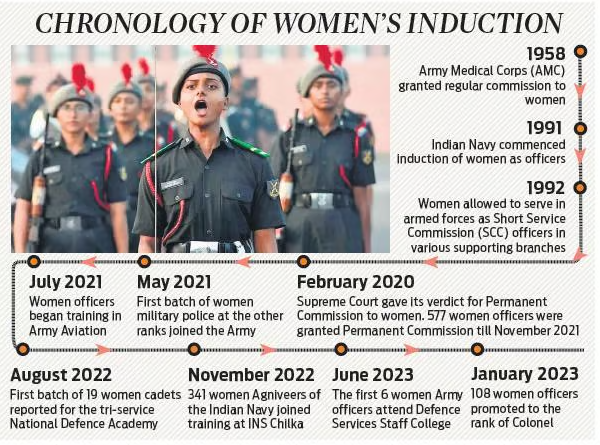
Women in Indian Defence Forces: Current Status
- Over 7,000 women personnel are serving in the Indian Army at present followed by 1,636 in the Indian Air Force and 748 in the Navy, as per data provided by GoI in March 2023.
- Indian Army: Consequent to grant of Permanent Commission to Women Officers (WOs), a gender-neutral Career Progression policy covering employment & promotional aspects was promulgated in Nov, 2021, providing equal opportunities to WOs in the Arms/Services where they are commissioned.
- Indian Air Force: Women officers are empowered to tenate key appointments including Commanding Officers in Combat Units of various field units.
- The rules in this regard are gender neutral and provide them equal opportunities.
- Their medical fitness and medical conditions are also factored prior to their effective utilization.
- Indian Navy: Officers are given opportunities for spouse co-location, re-settlement posting and compassionate grounds posting in a gender-neutral manner.
- Women are granted Maternity Leave and Childcare Leave etc. in addition to other leave applicable to their male counterparts.
Importance of Women in Armed Forces
- Diversity of thought and experience: Women bring diverse perspectives and problem-solving approaches to the table, fostering creativity and innovation leading to better decision-making and improved mission outcomes.
- Enhanced operational capabilities: Modern warfare relies heavily on technology, communication, and intelligence gathering. Women often excel in these areas, contributing significantly to the operational capabilities of the armed forces.
- Stronger social cohesion: Women’s presence can foster better understanding and communication between different communities and cultures, both within the forces and during deployments.
- Meeting recruitment challenges: Including women in the armed forces broadens the talent pool, allowing militaries to access a wider range of qualified recruits to meet their needs.
- Role models and inspiration: Seeing women excel in leadership roles and challenging traditional stereotypes inspires future generations, both within the military and in broader society.
Challenges Faced by Women in Armed Forces
- Deep-seated stereotypes and biases
- Low acceptance for women officers
- Sexual assault and harassment
- Pregnancy, post-partum recovery, and motherhood
- A lack of rules and regulations for women officers
Women in Defence: Situation in Other countries
- Women officially became eligible for combat positions in the American military in 2013.
- In 2018, the UK military lifted a ban on women serving in close combat ground roles, clearing the way for them to serve in elite special forces.
- Israel has gradually opened up 90% of its roles to women but they are still excluded from frontline combat roles in the main infantry units and some of the most elite commando units that traditionally operate across enemy lines in wartime.
{GS3 – IE – Securities} New FPI Fraud
- Context (IE): SEBI warns against fake trading platforms claiming ties to registered Foreign Portfolio Investors (FPIs).
- Fraudsters pretend to be SEBI-registered FPI employees, tricking people into downloading apps.
- These apps claim to enable share purchases, IPO subscriptions, and institutional account benefits without requiring an official trading or Demat account.
- SEBI has clarified that FPI investment is not open to resident Indians with limited exceptions as outlined in the SEBI (Foreign Portfolio Investors) Regulations, 2019.
- SEBI has not granted any relaxations to FPIs regarding securities market investments by Indian investors.
To know more about FPIs, visit > Foreign Portfolio Investment (FPIs)
{GS3 – IE – Trade} High Tariffs in India
- Context (IE): Government departments have raised concerns about imposing high duties to limit imports from China. They are calling for a more nuanced strategy in dealing with this issue.
- China accounts for 14 per cent of India’s imports.

- Globally, there is no country where tariffs are so high (as in India). In India, tariffs are higher than countries in Southeast Asia and even Africa.
- The average tariffs in India have jumped to 18.1% in 2022 from 13% eight years ago in 2014.

Issues/Challenges due to high tariffs
- Makes India’s exports uncompetitive in the global market Since our tariffs are high compared to countries such as Vietnam, Thailand, and Mexico.
- Vietnam provides lower tariffs for approximately 98% of tariff lines compared to India, while Thailand offers reduced tariffs for over 90% of goods.
- Loss of domestic output for Indian manufacturing.
- Possible Classification as Protectionist Country: Analysts warn that proposed customs duty hikes, in some instances, are surpassing the WTO-mandated bound rates. Breaching these rates could label a country as protectionist under WTO norms.
- Disincentive for Supply Chain Diversification beyond China.
- FTAs are less impactful without tariff reductions.
Industry Reactions due to hike in tariff in recent years
- All India Toys Federation protested against the import duty hike on toys in the year’s budget.
- New and Renewable Energy Ministry & solar project developers opposed the implementation of the duty hike on solar panels starting September 2017.
- The withdrawal of the exemption on cashew nuts in shell in Budget 2016-17 led to representations from trade and industry associations urging a reversal of the 5% duty on cashew nuts in the shell.
- The withdrawal of concessional customs duties on 76 specified drugs in January 2016 had to be partially reversed due to adverse impacts on drug prices and availability.
- MeitY advocated for a reduction of duties by about 20% on parts, including circuit boards, chargers, and fully assembled phones. This was partially accepted, and the government lowered duties on several IT goods before the Interim Budget 2024.
{GS3 – S&T – Biotech} Genome India Project (GIP)
- Context (TH | IE | PIB | TP): The Department of Biotechnology (DBT) officially completed the 10,000 genome project (Genome India project).
- Taking inspiration from the Human Genome Project, the Department of Biotechnology (DBT) initiated the ambitious Genome India Project (GIP) in 2020.
- It aims to collect 10,000 genetic samples from citizens across India, to build a reference genome.
- Gene Mapping project involves 20 leading institutions of the country with the Centre for Brain Research of Indian Institute of Science (IISc) Bangalore as the nodal point.
- India first sequenced a complete human genome in 2006.
- All the data are being stored at the Indian Biological Data Centre (IBDC) located at the Regional Centre for Biotechnology (RCB) in Faridabad.
- The IBDC is the country’s only databank. Prior to that, Indian researchers had to host their biological datasets on American or European servers.
- Countries like the UK, China, and the US also have projects to sequence a significant number of genomes.
Need for an India-specific database?
- India’s population of 1.4 billion comprises over 4,600 population groups, many of which are endogamous.
- This diversity has led to distinct genetic variations, with certain groups having a higher frequency of disease-causing mutations.
- Harmful mutations, less common globally, are concentrated at elevated rates within these endogamous groups in India. For example,
- A mutation MYBPC3 that leads to cardiac arrest at a young age is found in 4.5% of the Indian population but is rare globally.
- Another mutation called LAMB3 that causes a lethal skin condition is found in nearly 4% of the population near Madurai, but it is not seen in global databases.
|
Significance of GIP
- To gain deeper insight into India’s population diversity.
- Improve diagnostic methods and medical counselling.
- Find genetic predispositions to disease.
- Develop personalised and customisable drugs.
- Improve gene therapy.
- Throw more light on individual susceptibility to infectious disease.
- Help in identifying resistance-indicating variants. For example, genes that might make certain medicines or anaesthetics ineffective in certain populations.
India & Biotechnology
Human Genome Project
|
To know about how genome sequencing is done and its advantages, visit > Genome Sequencing.
{GS3 – S&T – Space} Gaganyaan Mission
- Context (IE): PM announces 4 astronauts for Gaganyaan Mission.
- Group Captain Prasanth Balakrishnan Nair, Group Captain Ajit Krishnan, Group Captain Angad Pratap, and Wing Commander Shubhanshu Shukla are India’s astronauts designate for Gaganyaan.
- Gaganyaan is the 1st human space flight programme of ISRO.
- Objective: To demonstrate indigenous capability of human space flight to low earth orbit.
- Launch vehicle: GSLV-Mk III, also called the LVM-3 (Launch Vehicle Mark-3).
- Payloads:
- Crew Module: It is the spacecraft carrying human beings.
- Service Module: It will support the crew module and is powered by liquid propellant engines.
- This mission consists of:
- Two unmanned missions (G1 & G2): 2nd uncrewed mission (G2) will carry “Vyommitra” (a female-looking humanoid robot developed by ISRO to function on-board the Gaganyaan).
- One manned mission (G3): The Orbital Module of the crewed mission will carry three Indian astronauts, including a woman into space for 7 days. It will orbit the Earth at a low-earth-orbit at an altitude of 300-400 km.
- India will become the 4th nation in the world to launch a Human Spaceflight Mission after USA, Russia, and China.
- Russia and France are cooperating with India for Gaganyaan mission.
Human rated LVM3 – HLVM3
- It is a three-stage vehicle with a 110 ton core liquid propellant stage (L-110) and a strap-on stage with two solid propellant motors, each with 200 tons propellant (S-200).
- The upper stage will be cryogenic fueled with a propellant loading of 25 tons (C-25).
- The LVM-3 has a lift-off mass of 640 tonnes, and it can carry a payload of up to 4,000 kilograms into geosynchronous transfer orbit (GTO) at 35,000 km.
- HLVM3 consists of Crew Escape System (CES) powered by a set of quick acting, high burn rate solid motors which ensures that Crew Module along with crew is taken to a safe distance in case of any emergency either at launch pad or during ascent phase.
Crew Escape System (CES)
- The CES is a part of the module that ensures “the crew is taken to a safe distance in case of any emergency either at launch pad or during ascent phase.”
- The Gaganyaan-1 mission’s crew module will not have the Environment Control and Life Support System, which ensures an Earth-like environment inside the module.
- Gaganyaan-1 will mainly test the safe re-entry of the crew module and proper orientation of the module when it splashes down in the sea.
- A second unmanned flight is planned with a pressurised crew module, in which the complete life support system will be tested.
- This flight will carry the robot ‘Vyommitra’ which will record all parameters to study the impact of the flight on humans.
- Test Vehicle Abort Mission-1 (TV-D1) will demonstrate the performance of the Crew Escape System.
Test Vehicle Abort Mission-1 (TV-D1)

- The Test Vehicle is a single-stage liquid rocket developed for this abort mission.
- The payloads consist of the Crew Module (CM) and Crew Escape Systems (CES) with their fast-acting solid motors, along with CM fairing (CMF) and Interface Adapters.
- CES with CM will be separated from the Test Vehicle at an altitude of about 17 km.
- Subsequently, the abort sequence will be executed autonomously commencing with the separation of CES and deployment of the series of parachutes, finally culminating in the safe touchdown of CM in the sea, about 10 km from the coast of Sriharikota.
Training of the astronauts
- The four astronauts completed their generic training at Russia’s Yuri Gagarin Cosmonaut Training Centre between February 2020 and March 2021.
- One of the four astronauts is expected to be trained by the American space agency NASA.
{Prelims – Envi – Species} Increase in Pseudo-Melanistic Tigers
- Context (TH): Odisha writes to NTCA for the introduction of tigers in Similipal Tiger Reserve from other landscapes.The request was made due to the emergence of sizable pseudo-melanistic tigers.

- Out of 30 tigers found in the Similipal Tiger Reserve 13 adult tigers (seven females and six males) were found to be pseudo-melanistic.
- No other wild habitat in the world has pseudo-melanistic tigers.
- The high frequency of pseudo-melanistic tigers in Similipal indicates strong stochastic effects and inbreeding. This phenomenon is largely localized to this population.
Stochastic Effect
|
{Prelims – In News} First Herpetofauna Survey
- Context (TH): The first herpetofaunal survey was conducted in the Core Area of the Mudumalai Tiger Reserve (MTR).
- A herpetofauna survey is done to identify and list all reptiles and amphibians, such as frogs, that can be present within the proposed area.
- It revealed 82 species of reptiles and amphibians.
- The survey could assist the forest department in implementing species-specific conservation plans.
- Key species identified include,
- Near-threatened Indian rock python.
- Vulnerable mugger crocodile.
{Prelims – In News} Scan and Share Service for ABDM
- Context (PIB): The National Health Authority (NHA) achieved a significant milestone of generating over 2 Crore tokens for Out-Patient-Department (OPD) registrations through the Ayushman Bharat Health Accounts (ABHA)–based Scan and Share service.
- NHA, under the Ayushman Bharat Digital Mission (ABDM), has introduced a QR-code-based solution in ABDM empanelled facilities.
- The QR code can be scanned with the mobile phone (using phone camera/scanner/ABHA app/Arogya Setu app/or any other ABDM-enabled app).
- It enables patients to share their demographic details and health records by scanning the QR code.
- This minimises the problem of long queues at health facilities and the entry of incomplete and inaccurate data.
{Prelims – PIN World – Africa} Agalega Island
- Context (PIB): A modern airstrip and a new jetty will be inaugurated at Agalega Island, Mauritius by Indian PM and PM of Mauritius.
- These projects aim to strengthen connectivity between Agalega Island and mainland Mauritius.
- Agalega Island is a dependency of Mauritius, which consists of two outer islands located in the southwest Indian Ocean, about 1,050 km (650 mi) north of Mauritius Island.
- The islands have a total area of 2,600 ha (6,400 acres).

{Prelims – S&T – Defence} NATO’s Steadfast Defender 2024
- Context (TH): North Atlantic Treaty Council (NATO) started its largest military exercise in Europe — the Steadfast Defender 2024 — at the end of January.

- It is the largest exercise conducted by the alliance since the Cold War.
- Objective: To highlight its collective military might and commitment to the security of its members, seemingly in light of Russia’s invasion of Ukraine.
- The exercise is being conducted in two parts:
- 1st phase (January end to mid-March) will focus on maritime reinforcement across the Atlantic and in the Arctic.
- 2nd phase (mid-February to end of May) will focus on using deployed reinforcements across all domains, from the Arctic to the Eastern Flank.
- The exercise incorporates land, air, sea, cyber, and space operations to enhance civil-military cooperation.





![PMF IAS Environment for UPSC 2022-23 [paperback] PMF IAS [Nov 30, 2021]…](https://pmfias.b-cdn.net/wp-content/uploads/2024/04/pmfiasenvironmentforupsc2022-23paperbackpmfiasnov302021.jpg)

